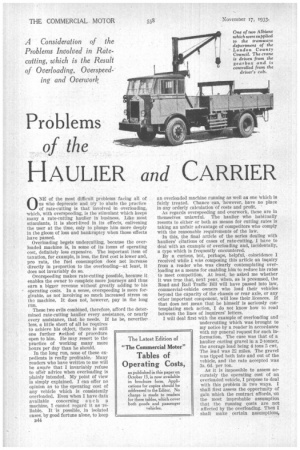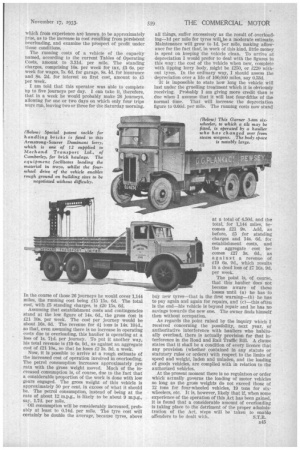Problems of the
Page 58

Page 59

If you've noticed an error in this article please click here to report it so we can fix it.
HAULIER and CARRIER 0 NE of the most difficult problems facing all of us who deprecate and try to abate the practice of rate-cutting is that involved in overloading, which, with overspeeding, is the stimulant which keeps many a rate-cutting haulier in business. Like most stimulants, it is short-lived in its effects, enlivening the user at the time, only to plunge him more deeply in the gloom of loss and bankruptcy when those effects have passed.
Overloading begets undercutting, because the overloaded machine is, in some of its items of operating cost, definitely less expensive. The important item of taxation, for example, is less, the first cost is lower and, pro rata, the fuel consumption does not increase directly in proportion to the overloading—at least, it does not invariably do so.
Overspeeding makes rate-cutting possible, because it enables the owner to complete more journeys and thus earn a bigger revenue without greatly adding to his operating costs. In a sense, overspeeding is more forgivable, as not involving so much increased stress on the machine. It does not, however, pay in the long run.
In the long rim, none of these expedients is really profitable. Many readers who have written to me will be aware that I invariably refuse to offer advice when overloading is plainly intended. My point of view is simply explained. I can offer no opinion as to the operating cost of any vehicle which is consistently overloaded. Even when I have data available concerning sue li a machine, I cannot regard it as reliable. It is possible, in isolated cases, by good fortune alone, to keep
B44 an overloaded machine running as well as one which is fairly treated. Chance can, 'however, have no place' In any orderly calculation of costs and profit. '
As regards overspeeding and overwork, these are in themselves unlawful. The haulier who habitually resorts to either or both as means for cutting rates is taking an unfair advantage of competitors who comply with the reasonable requirements of the law.
In this, the final article of the series dealing with hauliers' citations of cases of rate-cutting, I have to deal with an example of overloading and, incidentally, a type which is frequently encountered.
By a curious, but, perhaps, helpful, coincidence I received while I was composing this article an inquiry from a reader who was clearly contemplating overloading as a means for enabling him to reduce his rates • to meet competition. At least, he asked me whether it was true that, next year, When, as is presumed, the Road and Rail Traffic Bill will have passed into law, commercial-vehicle owners who load their vehicles beyond the capacity of the chassis or rear axle, or any other important component, will lose their _licences. If that does not mean that he himself is seriously contemplating such action, I do not know how to read between the lines of inquirers' letters.
I will deal first with the example of overloading and undercutting which was brought to my notice by a reader in accordance with my general request for such information. The case was that of a haulier calling gravel in a 2-tonner, the average load being 4 tons 5 cwt. 'The lead was 22 miles. The gravel was tipped both into and out of the vehicle, and the rate accepted was 3s. fid. per ton.
As it is impossible to assess accurately the operating cost of an overloaded vehicle, I propose to deal with this problem in two ways. I shall first assess the opportunity of gain which the contract affords, on the most improbable assumption that the running costs are not affected by the overloading. Then I shall make certain assumptions?
which from experience are known to be approximately true, as to the increase in Cost resulting from persistent 'overloading, and examine the prospect of profit under those conditions.
The running costs of a vehicle of the capacity named, according to the current Tables of Operating Costs, amount to 3.31d. per mile. The standing charges, comprising 10s. per week for tax, £3 Os. per week for wages, 7s. 6d. for garage, 8s. lid. for insurance and 8s. 2d. for interest on first cost, amount to 15 per week.
I am told that this operator was able to complete up to live journeys per day. I can take it, therefore, that in a week he would probably make 26 journeys, allowing for one or two days on which only four trips were run, leaving two or three for the Saturday morning.
In the course of those 26 journeys he would cover 1,144 miles, the running cost being £15 15s. 6d. The total cost, with 15 standing charges, is £20 15s. 6d.
Assuming that establishment costs and contingencies stand at the low figure of 14s. 6d., the gross cost is £21 10s. per week. The cost per journey would be about 16s. 6d. The revenue for 41 tons is 14s. bid., so that, even assuming there is no increase in operating Costs due to overloading, this haulier is operating at a loss of is. 7id. per journey. To put it another way, his total revenue is £19 Os. 9d., as against an aggregate cost of £21 108., so that he loses £2 3s. 3d. a week.
Now, it is possible to arrive at a rough estimate of the increased cost of operation involved in overloading. The petrol consumption increases approximately pro rata with the gross weight moved. Much of the increased consumption is, of course, due to the fact that a considerable proportion of the work is done with low gears engaged. The gross weight of this vehicle is approximately 50 per cent, in excess of what it should be. The petrol consumption, instead of being at the rate of about 12 m.p.g., is likely to be about 9 m.p.g., say, 1.7d. per mile.
Oil consumption will he considerably increased, probably at least to 0.141. per mile. The tyre cost will certainly be double the average, because tyres, above all things, suffer excessively as the result of .overloading—id per mile for tyres will,be a moderate estimate. Maintenance will grow to id. per mile, making allowance for the fact that in work of this kind, little money is spent on keeping the vehicle clean. To arrive at depreciation I would prefer to deal with the figures in this way: the cost of the vehicle when new, complete with tipping lorry body, might be £250, or £220 without tyres. In the ordinary way, I should assess the depreciation over a life of 100,000 miles, say 0.53d.
It is impossible to state how long the vehicle will last under the gruelling treatment which it is obviously receiving. Probably 1 am giving more credit than is due when I assume that it will last four-fifths of the normal time. That will increase the depreciation figure to 0.66d. per mile. The running costs now stand at a total of 4.50d. and the total, for 1,144 miles, becomes £21 9s. Add, as before, £5 for standing charges and 14s. 6d. for establishment costs, and the aggregate cost becomes £27 3s. 6d., as against a revenue of £19 Os. 9d., which results In a dead loss of £7 16,e. 9d. per week.
The point is, of course. that this haulier does not become aware of these losses until (a) he has to buy new tyres—that is the first warning--(b) he has to pay again and again for repairs, and (c)—this often is the end—his vehicle is beyond repair and he has no savings towards the new one. The owner finds himself then without occupation.
As regards the point raised by the inquiry which I received concerning the possibility, next year, of authoritative interference with hauliers who habitually overload, there is actually provision for that interference in the Road and Rail Traffic Bill. A clause states that it shall be a condition of every licence that any provision (whether contained in any statute or statutory rules or orders) with respect to the limits of speed and weight, laden and unladen, and the loading of goods vehicles, are complied with in relation to the authorized vehicles.
At the present moment there is no regulation or order which actually governs the loading of motor vehicles so long as the gross weights do not exceed those of 12 tons for four-wheeled vehicles, 19 tons for sixwheelers, etc. It is, however, likely that if, when some experience of the operation of this Act has been gained, it is found that a considerable amount of overloading is taking place to the detriment of the proper administration of the Act, steps will he taken to enable offenders to be dealt with. S.T.R.




























































































